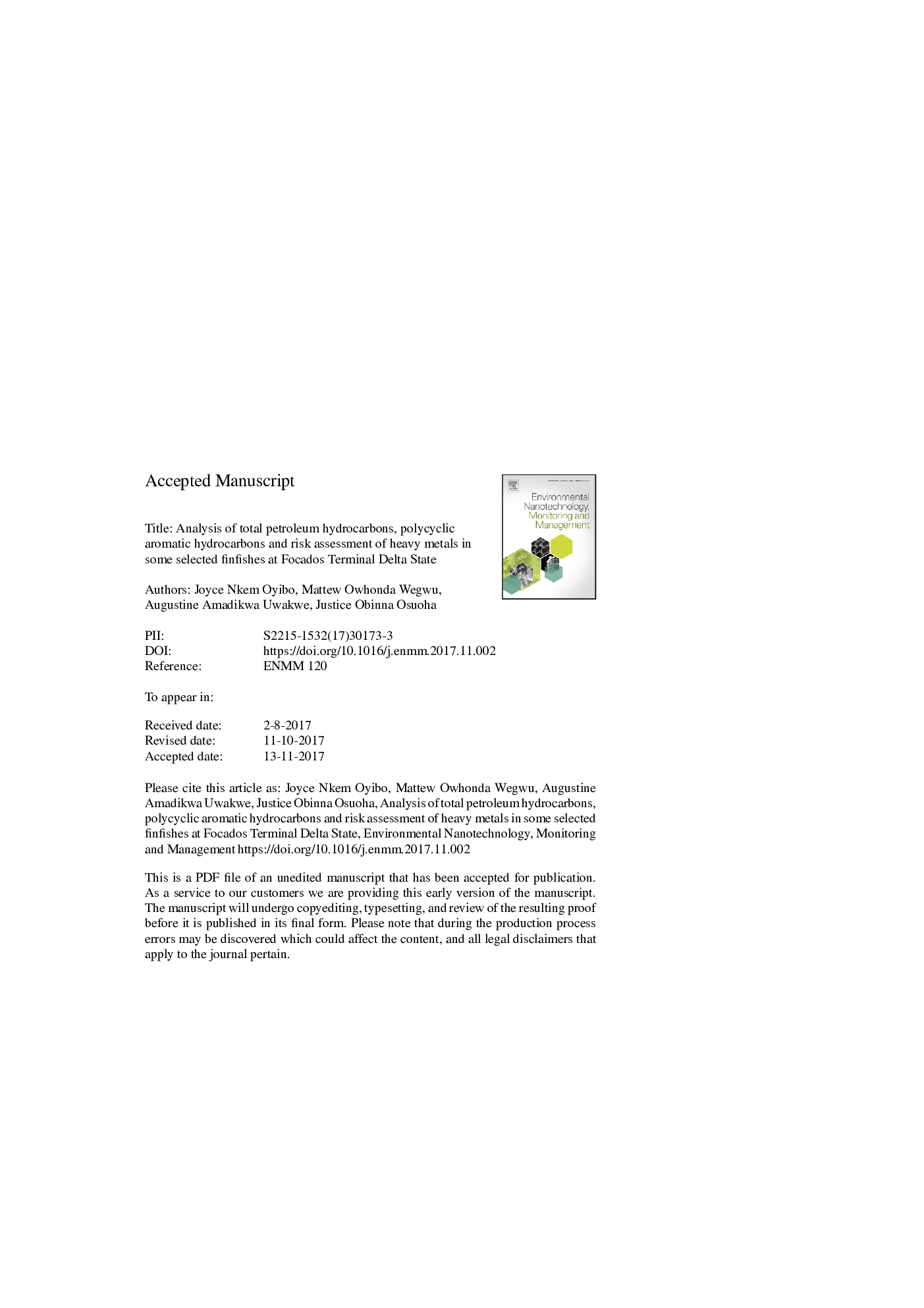| کد مقاله | کد نشریه | سال انتشار | مقاله انگلیسی | نسخه تمام متن |
|---|---|---|---|---|
| 8855661 | 1619098 | 2018 | 22 صفحه PDF | دانلود رایگان |
عنوان انگلیسی مقاله ISI
Analysis of total petroleum hydrocarbons, polycyclic aromatic hydrocarbons and risk assessment of heavy metals in some selected finfishes at Forcados Terminal, Delta State, Nigeria
دانلود مقاله + سفارش ترجمه
دانلود مقاله ISI انگلیسی
رایگان برای ایرانیان
کلمات کلیدی
موضوعات مرتبط
علوم زیستی و بیوفناوری
علوم محیط زیست
شیمی زیست محیطی
پیش نمایش صفحه اول مقاله

چکیده انگلیسی
Edible aquatic fin fishes (I. africana, S. scrombrus, C. saira, T. crocodilus, O. niloticus, T. lepturus and M. cephalus) obtained from Forcados Terminal river in Delta State, Nigeria were analyzed for content in total petroleum hydrocarbons (TPHs), polycyclic aromatic hydrocarbons (PAHs) and heavy metals. Health risks to human through dietary consumption of seafood were assessed by estimated dietary intake (EDI), estimated weekly intake (EWI) and Target hazard quotient (THQ). Total Aliphatic Hydrocarbon (TAH) showed highest concentration of 0.49â¯Â±â¯0.29, 0.59â¯Â±â¯0.94 and 0.97â¯Â±â¯0.64â¯mg/kg in hexadecane (I. africana), tetracosane and tetradecane (S. scrombrus). Polycyclic Aromatic Hydrocarbon (PAH) like naphthalene, methylnaphthalene, Acenaphthene and Acenaphthene showed highest mean concentrations of 0.06â¯Â±â¯0.03, 0.08â¯Â±â¯0.05, 0.05â¯Â±â¯0.03 and 0.05â¯Â±â¯0.04 in I. africana. The result of total petroleum hydrocarbon showed S. scrombrus revealed the highest mean concentration of 3.64â¯Â±â¯0.94â¯mg/kg while M. cephalus gave the least Concentration of 0.08â¯Â±â¯0.01â¯mg/kg. Heavy metals like Fe, Zn and Cu had their peak concentrations of 46.59â¯Â±â¯0.34 (S. scrombrus), 10.56â¯Â±â¯0.18 (C. saira) and 5.95â¯Â±â¯0.03â¯mg/kg (S. scrombrus) respectively and it shows a significant difference (pâ¯<â¯.05) when compared to the control. Other heavy metals of health concern like Pb, Cd and showed highest concentration as follows 5.54â¯Â±â¯0.02 (M. cephalus), 0.68â¯Â±â¯0.01 (Tilapia) and 0.01â¯Â±â¯0.00â¯mg/kg (C. saira). The results showed that the THQ for Fe, Cr and Zn and were less than 1 while that of Pb was greater than 1. The findings from this study show that there is a considerable health risks connected with consumption of some sea animals from our study locale and these aquatic animal bioaccumulate heavy metals, PAHs and TPHs levels which are potentially poisonous to humans who consume them.
ناشر
Database: Elsevier - ScienceDirect (ساینس دایرکت)
Journal: Environmental Nanotechnology, Monitoring & Management - Volume 9, May 2018, Pages 128-135
Journal: Environmental Nanotechnology, Monitoring & Management - Volume 9, May 2018, Pages 128-135
نویسندگان
Joyce Nkem Oyibo, Matthew Owhonda Wegwu, Augustine Amadikwa Uwakwe, Justice Obinna Osuoha,